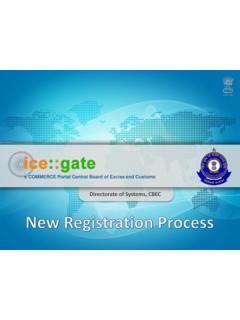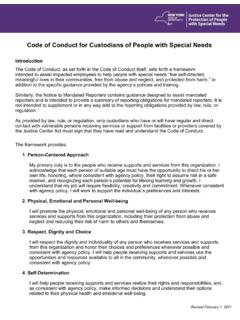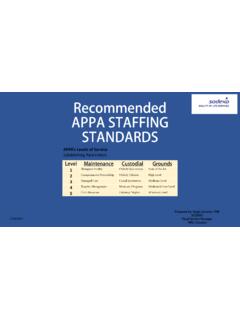Transcription of HEAD CUSTODIANS, CUSTODIAL STAFF, AND …
1 HEAD CUSTODIANS, CUSTODIAL STAFF, AND MAINTENANCE PERFORMANCE REVIEW PROGRAM SOUTH BURLINGTON SCHOOL DISTRICT 550 Dorset Street South Burlington, Vermont 05403 (802) 652-7250 Head custodian , CUSTODIAL Staff, and Maintenance Performance Management Program Page 2 Head custodian , CUSTODIAL Staff, and Maintenance Performance Management Program Table of Contents Page I. Introduction .. 3 II. Components of the Performance Management 3 Performance Rubrics/Standards .. 3 Goal 3 Annual Discussion 3 III. Rating Scale for Performance Standard 4 Rating 4 Rating 4 IV. Performance Evaluation 4 Level 1: New 4 Level 2: Continued 5 Level 3: Employees in a Performance Improvement 7 V. 9 Standard I: Demonstrates Job 9 Standard II: Provides Quality 10 Standard III: Maintains Effective Working 11 Standard IV: Actively Participates in Professional Growth and 12 Standard VI: Organizational Requirements.
2 13 VI. Forms Self-Evaluation/Feedback 14 Goal Setting 16 Head custodian , CUSTODIAL Staff, and Maintenance Performance Management Program Page 3 Head custodian , CUSTODIAL Staff, and Maintenance Performance Management Program I. Introduction This performance management program applies to South Burlington School District Head custodian , CUSTODIAL Staff, and Maintenance employees. The purpose of this program is to create an opportunity for communication between the employee and his/her supervisor in order to: Recognize performance that meets or exceeds expectations. Set work expectations (behavior, vital activities, and outcomes) for future performance. Provide timely feedback to enable employees to better manage their performance. Define areas for employee growth and development.
3 Allow for an individualized and specific performance improvement plan. Periodic Feedback: Over the course of the year, the employee and the supervisor may meet informally or formally to review progress made to date on performance goals, address any old or new performance concerns, and adjust performance goals and timelines if appropriate. II. Components of the Performance Management Program The performance management program is made up of the following components: Performance Standards Rubric: Performance expectations are described in a rubric, divided into five (5) sections. These sections are: 1) Job Knowledge 2) Quality of Work 3) Effective Working Relationships 4) Cooperation/Teamwork and 5) Initiative. These expectations have been created for CUSTODIAL and maintenance employees and defines the standard by which employee performance is to be measured.
4 This will be the basis for the regular performance feedback and may be provided at any time, but at least every third year of employment. Goal Setting: Specific annual objectives to promote employment performance, professional growth, or increased proficiency in a related job area are a part of the evaluation process. Ideally, objective setting should be a collaborative effort between the supervisor and employee to ensure congruence with District Ends and department goals. Goals should include how much, of what and by when. Goals should be visited periodically to measure progress and to make changes, if needed. Annual Discussion Form: The employee is given an opportunity to comment on his/her performance and professional development needs in this annual component of the evaluation process.
5 A standard form is provided at least two (2) days prior to an evaluation meeting and must be completed and returned to the employee s supervisor at the time of the meeting. After a discussion, this component will be rated as either satisfactory or unsatisfactory , this information will be documented and sent to the employee s file. Head custodian , CUSTODIAL Staff, and Maintenance Performance Management Program Page 4 III. Rating Scale for Performance Standards Rubric Rating Scale: The performance evaluation form will contain a four point scale and will have the following rating labels: E = Exceeds Standard; M=Meets Standard; N=Needs Improvement; U= Unmet Standards. The Not Applicable rating may only be applied in few instances where job responsibilities do not coincide with standards and an explanation must be provided whenever this is used.
6 This terminology allows for more active reflection of performance. Rating Definitions: 1. Exceeds Standard (E): This rating is given to an employee who consistently exceeds the job standards. This person is often called on to mentor or assist others. Demonstrates initiative and adapts concept of standards to better perform one s job responsibilities. 2. Meets Standard (M): This rating is given to an employee who demonstrates a thorough understanding of the standards, practices the standards continuously, and works independently without constant supervision. This person may be called on to collaborate with others on special projects or assignments. 3. Needs Improvement in Standard (N): This rating is given to an employee who demonstrates a basic understanding of the standards, practices the standards inconsistently and/or needs some supervision.
7 This person may be given opportunities for collaboration with others on special projects and/or assignments. 4. Unmet Standards (U): This rating may be given for new, inexperienced, or performance challenged employees who demonstrate limited or no understanding of the standard. If the employee does not meet expectations in one or more areas and there is no evidence of improvement, a plan for performance improvement may be developed with the intent to improve the areas of deficiency. Specific information may be found in the Performance Improvement Plan (PIP) information outlines further in this document. 5. Not Applicable (NA): This rating may only be applied in few instances where job responsibilities do not coincide with standards. An explanation must be provided whenever this is used.
8 IV. Performance Evaluation Cycles Level 1 (New Employees): For purposes of this program, one who is subject to this performance evaluation cycle will include a new employee who: Has no previous regular employment in the District within the job classification; Is rehired after termination for any reason except: his/her illness or injury, approved leave of absence, or layoff within the recall period; or Is new to the district or department. Head custodian , CUSTODIAL Staff, and Maintenance Performance Management Program Page 5 All new employees will participate in the performance evaluation process within the probation period established for the employee s job group. The purpose of the initial evaluation process is to provide evidence for continued employment, to set job expectations, and to provide meaningful feedback and support for the employee.
9 Level 1 Evaluation Process: 1. Supervisor and Employee Initial Meeting: At the beginning of employment, the supervisor will meet with the employee to review the job description, daily job expectations, clarify roles and responsibilities, and explain the evaluation process. At this time, the supervisor will set initial goals. 2. Probation Period Feedback: By the end of the probationary period (first 60 days of employment), the employee and the supervisor will meet to review performance and progress made to date on initial goals. If performance is satisfactory, the supervisor and employee will set new or update performance goals and mutually set a date for next meeting/annual review. If performance is unsatisfactory, the supervisor may continue the probationary period, terminate employment, or place the employee in a Performance Improvement Plan (PIP) for a designated amount of time, as outlined in the plan.
10 At the end of the PIP s designated time, the supervisor has the option to assign the employee to a regular evaluation cycle, continue the employee under a new PIP, or terminate employment for just cause. 3. Required Documentation: Performance information is to be included in the personnel file in the Superintendent s Office and will include the Assessment/Evaluation form with rubrics, Feedback Goal Forms, and any appropriate supplemental information from the employee. Level 2 (Current Employees): For purposes of this program, one who is subject to this performance evaluation cycle will include a current employee who has: successfully completed the first year of employment in the department, and has not been placed in a Performance Improvement Plan (PIP.) Current employees will be formally reviewed at least every third year of employment; however, management reserves its right to conduct formal performance evaluations sooner, as the need arises.






